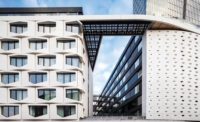Located underneath the Oregon Zoo, the Washington Park Tri-Met Station is a bustling hub for visitors traveling across Portland, OR. It is the only completely underground station in the Metropolitan Area Express (MAX) system, and at 260 feet below the surface, it is the deepest transit station in the world.
ZGF Architects originally designed the station, which opened in 1998. The same firm returned in the fall of 2017 to refresh and re-clad the transit hub, with the goal of brightening the space and alleviating the feeling of being so far underground.

For a public mass transit system, graffiti and vandalism are big concerns. ZGF needed a surfacing material that was easy to clean and durable enough to withstand high-traffic and everyday wear. The design team turned to Caleb Dare, an architectural representative at Facades Northwest, to discuss options for cladding that would meet the project’s needs.
“At first ZGF was considering a high-density fiber cement panel system,” said Dare. “But ultimately, they decided on Neolith because of its leading performance characteristics.” Neolith Sintered Stone is color-stable, low-maintenance and non-porous, making it extremely hygienic and resistant to heat, scratching, staining and harsh chemicals, explained the architectural representative.

ZGF wanted to put Neolith to the test before they specified it for the project. The team took samples to their office and defaced them with permanent marker and spray paint, let them sit in the sun for two months and then cleaned them with chemical cleaners and abrasive pads. The results spoke for themselves. Neolith’s non-porous, easy-to-clean surface, effortlessly passed the test.
With the right surfacing product selected for the new cladding, ZGF was ready to make their vision a reality. The firm chose a selection of Neolith Arctic White, Iron Frost and Nieve Satin designs in 6 mm thickness.
During construction, the station had to remain operational, so the installation process was carefully executed. Each of the 696 cut-to-size panels were fabricated on-site and installed in a mosaic pattern throughout the elevator lobby and train tunnel entrance using a hidden chemical adhesive bonding agent.

“The varying panel sizes and finishes give the station texture and depth, while dramatically brightening the space,” said Michael Speck, associate partner at ZGF Architects. “Coupled with the new lighting, our design with Neolith’s three different shades of white completely transformed the station. Through this process, I’ve learned that Neolith can be installed in just about any configuration.”
Neolith’s sleek design transformed the Washington Park Station with style and durability that will withstand the test of time.
|
Washington Park Tri-Met Station Portland, ORArchitect: ZGF Architects |






